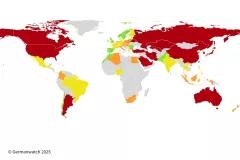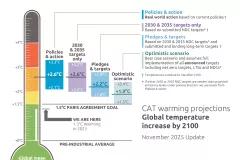05 October, NewClimate Institute
The new international climate change deal, the Paris Agreement, will enter into force just 11 months after its adoption. The record breaking timing of the ratification process demonstrates the extent to which national governments are serious about their commitment to the new Agreement. This is a historic step forward. Global climate change is now firmly established on the international agenda. The Agreement ushers in a shift to a complete phase out of fossil-fuel combustion.
But with the entry into force of the Paris Agreement, the work is only just beginning. Now, all countries have to actually implement the proposals they set out for reducing their greenhouse gas emissions (the Nationally Determined Contributions, NDCs). In many countries, this will involve the implementation of new policies and measures to achieve climate change mitigation. Countries such as the USA or Canada would miss their targets by a wide margin without the introduction of new measures; other countries, such as China and the EU, also need to do more.
However, even if all countries’ proposals were fully implemented, the combined mitigation impact would fall far short of that required to limit global climate change to the thresholds determined in the Paris Agreement. The Agreement states that countries commit to limiting global temperature increase to “well below 2°C above pre-industrial levels” and to further pursue efforts to limit the increase to 1.5°C. With the full implementation of all national proposals in their current form, global temperature increase would reach approximately 3°C by the end of the century (see Climate Action Tracker or Article in Nature).
This means that all countries must work to increase their ambition as quickly as possible, looking to new ways of reducing emissions and phasing out fossil fuels completely in the long-term. For 1.5°C in particular, the window of opportunity is closing rapidly: waiting until 2018, when the next round of revised national proposals are expected to be presented, will be too late.
For example, Germany must review and adapt its 2050 Climate Change Plan to bring it in line with the Paris Agreement targets of “well below 2°C” and in the direction of 1.5°C. Amongst other things, Germany’s energy transition must be substantially accelerated. Climate neutrality must clearly be reached by 2050. The shift away from fossil fuel combustion towards 100% renewable energy should also be completed before 2050. This includes the complete phase out of coal, which must occur even earlier. In the transport sector, conventional technologies for petrol and diesel vehicles must be abandoned in favour of alternatives, such as electric vehicles; under strict interpretation of the Paris Agreement targets, no more conventional petrol or diesel vehicles should be sold after 2025.
The ratification of the Paris Agreement brings the world a step closer to limiting climate change, but many more steps are necessary to actually achieve it.






